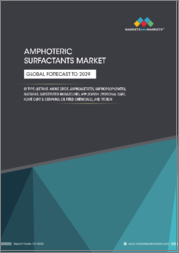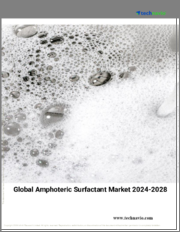
|
시장보고서
상품코드
1771361
세계의 양성 계면활성제 시장 수요 및 예측 분석(2018-2034년)Global Amphoteric Surfactants Market Demand & Forecast Analysis, 2018-2034 |
||||||
세계 양성 계면활성제 시장은 퍼스널케어, 가정용 세제, 섬유, 산업용 수요 증가로 인해 최근 몇 년 동안 꾸준한 성장세를 보이고 있습니다. 양성 계면활성제는 pH 수준에 따라 양전하와 음전하를 띠고, 뛰어난 안정성, 순함, 다용도성을 부여하는 특징이 있습니다. 이러한 특성은 특히 샴푸나 액체 비누와 같은 퍼스널케어 제품에 이상적입니다. 또한 거품 안정제, 습윤제, 분산 보조제로서 작용하기 때문에 가정용 및 상업용 세제, 유전용 화학제품, 농약 등에서도 유용하게 사용되고 있습니다. 제조업체들이 순하고 효과적이며 친환경적인 솔루션을 원하는 소비자의 기대에 부응하기 위해 노력함에 따라, 양성 계면활성제는 많은 제제에서 선호되는 성분으로 부상하고 있습니다.
지역 수요 분석
아시아태평양은 중국, 인도, 한국, 동남아시아 및 기타 국가의 급속한 산업화와 소비자 수요 증가로 인해 양친매성 계면활성제의 가장 큰 시장으로 부상하고 있습니다. 이들 지역의 퍼스널케어 및 가정용 부문은 중산층 인구 증가와 생활수준의 향상으로 인해 빠르게 성장하고 있습니다. 북미와 유럽은 퍼스널케어, 제약, 산업 부문의 안정적인 수요로 그 뒤를 잇고 있습니다. 이들 경제권에서는 순하고 생분해성 화학물질에 대한 규제적 요구가 높아지면서 양친매성 계면활성제가 기존 제품보다 유리하게 작용하고 있습니다. 라틴아메리카, 중동 및 아프리카 등 신흥 지역은 특히 농업, 청소 및 퍼스널케어 분야에서 현지 제조 및 소비자 수요 증가로 인해 성장세를 보이고 있습니다.
시장 역학
양성 계면활성제 시장은 환경에 미치는 영향이 적고, 더 깨끗하고 순한 성분을 찾는 추세에 따라 형성되고 있습니다. 피부 과민증과 알레르기에 대한 소비자의 인식이 기존의 자극적인 계면활성제에서 보다 순한 양성 계면활성제로의 전환을 촉진하고 있습니다. 한편, 산업 부문에서는 다양한 pH 및 온도 조건에서 높은 효과를 필요로 하는 제제에서 이러한 성분들이 계속 선호되고 있습니다. 기술 혁신은 보다 효율적인 생산 방식, 비용 구조 개선, 환경 영향 감소로 이어지고 있습니다. 생분해성 계면활성제에 대한 유럽과 미국의 규제 요구도 이러한 변화를 촉진하고 있습니다. 그러나 원자재 가격 변동(대부분 석유화학제품 비용과 관련이 있음)과 저렴한 지역 대체 제품과의 경쟁이라는 과제는 여전히 남아 있습니다.
시장 성장 촉진요인 : 순한 성분 배합에 대한 수요 증가
이 시장의 주요 촉진요인은 저자극성, 피부 친화적인 퍼스널케어 제품에 대한 소비자 수요 증가입니다. 양성 계면활성제는 자극 없이 거품이 나고 세정력이 뛰어나 민감한 피부와 베이비 케어 제품에서 중요한 틈새를 채우고 있습니다. 소비자들이 성분 표시를 꼼꼼히 읽고 더 순한 제품을 선호함에 따라 제조업체들은 샴푸, 세안제, 비누의 성분을 양성 성분으로 변경하고 있습니다. 이러한 변화는 선진국에서 특히 두드러지게 나타나고 있으며, 이는 혁신을 촉진하고 전체 미용 및 의료 브랜드의 제품 라인 확장을 촉진하고 있습니다.
시장 성장 억제요인: 원자재 변동성 및 비용 압력
양성 계면활성제는 그 장점에도 불구하고 원료의 변동성과 비용 압력으로 인한 문제에 직면하고 있습니다. 많은 원료가 석유화학 중간체에서 파생되기 때문에 그 가격은 석유 시장의 변동에 민감합니다. 상대적으로 복잡한 제조 공정이 있기 때문에 이러한 변동은 비용 구조에 영향을 미쳐 최종 사용자에 대한 가격을 상승시킬 수 있습니다. 비용 경쟁력이 중요한 지역, 특히 순도가 중요하지 않은 산업용 및 세정 용도에서 일부 제조업체는 더 저렴한 대체 계면 활성제를 선택할 수 있습니다. 제품의 품질과 지속가능성을 유지하면서 이러한 압력을 관리하는 것은 시장 진출기업에게 여전히 중요한 과제입니다.
세계의 양성 계면활성제 시장에 대해 조사 분석했으며, 시장 역학 및 산업 동향, 각 부문별 수요, 제조업체 프로파일 등의 정보를 전해드립니다.
목차
제1장 서론
제2장 시장 요약
- 시장 발전
- 수요 개요
- 산업 구조
- 전략상 문제
- 최종 용도 동향
- 성장 예측
제3장 경제와 에너지 전망
- GDP와 인구통계
- 금융 정책과 재정 정책
- 원유 생산과 가격
- 천연가스
- 전기요금
제4장 최종 용도 부문 실적
- 텍스타일
- 식품 및 음료
- 건축 및 건설
- 퍼스널케어
- 유전용 화학제품
- 페인트 및 코팅
- 상업용 및 가정용 세제
- 기타
제5장 양성 계면활성제 서론과 시장 개요
- 제품 설명
- 등급과 특성
- 원재료
- 제조 공정
- 환경 문제
- 밸류체인
- 용도
제6장 시장 역학과 산업 동향
- 시장 역학
- 성장 촉진요인
- 성장 억제요인
- 기회
- 과제
제7장 세계의 양성 계면활성제 수요 분석 : 유형별, 용도별(수량과 금액)(2018년-2034년)
- 전략상 문제와 COVID-19의 영향
- 수요 분석과 예측(2018년-2034년)
- 수요
- 수요 성장률
- 성장 촉진요인 분석
- 세계의 양성 계면활성제 시장 : 유형별
- 이미다조린 유도체
- 베타인
- 제4급 암모늄 화합물
- 아민 축합물
- 기타
- 세계의 양성 계면활성제 시장 : 용도별
- 가정용 세제
- 퍼스널케어
- 페인트 및 코팅
- 텍스타일
- 상업용 세제
- 유전용 화학제품
- 식품 가공
- 농약
- 건축 및 건설
- 플라스틱
- 기타
제8장 수요 분석과 시장 리뷰 : 지역/국가별(수량과 금액)(2018년-2034년)
- 전략상 문제와 COVID-19의 영향
- 수요 분석과 예측(2018년-2034년)
- 수요
- 수요 성장률
- 양성 계면활성제 시장 : 유형별
- 양성 계면활성제 시장 : 용도별
- 북미
- 미국
- 캐나다
- 멕시코
- 서유럽
- 독일
- 프랑스
- 이탈리아
- 영국
- 스페인
- 기타 서유럽
- 중유럽 및 동유럽
- 러시아
- 폴란드
- 기타 중유럽 및 동유럽
- 아시아태평양
- 중국
- 일본
- 인도
- 한국
- 기타 아시아태평양
- 중남미
- 중동 및 아프리카
제9장 가격 분석
제10장 주요 전략상 문제와 사업 기회 평가
- 시장의 매력 평가
- 전망과 타겟 시장 조사
제11장 전략적 추천과 제안
제12장 기업 분석
- 양성 계면활성제 제조업체 개요/기업 분석
- 기본 상세
- 본사 및 주요 시장
- 소유
- 기업 재무
- 제조거점
- 세계의 판매
- 총 직원수
- 제품 포트폴리오/서비스/솔루션
- 채택된 주요 사업 전략과 Prismane Consulting 개요
- 최근 발전
- 대상 기업
- AkzoNobel N.V.
- Cognis Corporation
- Degussa Corporation
- Harcros Chemical
- Lonza Incorporated
- Mclntyre Group
- Stepan Company
- Rhodia Incorporated
- 기타 제조업체
제13장 부록
LSH 25.07.23The global amphoteric surfactants market has witnessed steady growth in recent years, driven by increasing demand from personal care, household cleaning, textiles, and industrial applications. Amphoteric surfactants are unique because they carry both positive and negative charges depending on the pH level, giving them exceptional stability, mildness, and versatility. These characteristics make them ideal for gentle formulations, especially in personal care products like shampoos and liquid soaps. Their ability to act as foam stabilizers, wetting agents, and dispersion aids also makes them valuable across household and industrial cleaning, oil-field chemicals, and agrochemicals. As manufacturers strive to meet consumer expectations for mild, effective, and environmentally-friendly solutions, amphoteric surfactants are emerging as preferred ingredients across many product formulations.
Demand by Type
Amphoteric surfactants are produced in several major types, including imidazoline derivatives, betaines, quaternary ammonium compounds, amine condensates, and others. Betaines, renowned for their gentle cleansing properties, are leading the market due to widespread adoption in shampoos, baby care, and facial cleansers. Imidazoline derivatives and amine condensates are commonly used in industrial cleaning, oil-field formulations, and agrochemical products for their high stability under harsh conditions. Quaternary ammonium compounds perform dual roles as surfactants and disinfectants, making them suitable for specialized applications in wastewater treatment and microbial control. Each type offers unique functionality and is selected based on end-use requirements such as foaming, antimicrobial activity, or complex formation.
Demand by Application
Amphoteric surfactants are used across a vast range of applications, including household detergents such as laundry and dishwashing agents, where they help maintain foam and improve cleaning efficacy. In personal care, they serve as mild cleansers and foam boosters in shampoos, liquid soaps, bar soaps, and skincare products, offering a softer alternative to harsh sulfate surfactants. Paints & coatings rely on amphoteric surfactants as dispersants, antifoaming agents, and wetting agents to improve product stability and surface finish. The textile industry uses them to treat both synthetic and natural fibers, enhancing dye uptake and fabric feel. They are also found in industrial cleaning solutions, oil-field chemicals, food processing, agrochemicals, building & construction applications, plastics, and other specialized uses. This wide application spectrum underscores their versatility and importance in modern formulations.
Regional Demand Analysis
Regionally, Asia-Pacific stands as the largest market for amphoteric surfactants, driven by rapid industrialization and rising consumer demand in countries like China, India, South Korea, and Southeast Asia. The personal care and household segments in these regions are growing fast due to an expanding middle-class population and improving living standards. North America and Europe follow closely, with stable demand in personal care, pharmaceuticals, and industrial sectors. Regulatory emphasis on mild and biodegradable chemicals in these economies favors amphoteric surfactants over conventional options. Emerging regions such as Latin America, the Middle East, and Africa are gaining traction as local manufacturing and consumer demand rise, particularly in agriculture, cleaning, and personal care.
Key Manufacturers
Key players driving the global market include Nouryon, Cognis (now part of BASF), Degussa (Evonik), Harcros Chemical, Lonza, McIntyre Group, Stepan Company, Rhodia (Solvay), and various regional producers. These manufacturers invest in research and development to create surfactants that are milder, more biodegradable, and better-performing. For instance, Lonza focuses on amphoterics used in personal care and pharmaceutical products known for skin compatibility. Stepan and Solvay provide versatile solutions across household cleaning, industrial, and oil-field applications. Regional manufacturers offer competitively priced alternatives tailored to local requirements, such as agrochemical-grade betaines and industrial-grade amine condensates. The competitive landscape is characterized by strategic investments in sustainable production and regional expansion.
Market Dynamics
The amphoteric surfactants market is shaped by trends toward cleaner, milder ingredients with lower environmental impact. Consumer awareness around skin sensitivity and allergies has driven a shift from traditional harsh surfactants to milder amphoterics. Meanwhile, industrial sectors continue to prefer these ingredients in formulations requiring high efficacy under varying pH and temperature conditions. Technological innovation has led to more efficient production methods, improving cost structures and reducing environmental impact. Regulatory demands in Europe and North America for biodegradable surfactants support this shift. However, challenges such as fluctuating raw material prices-often linked to petrochemical costs-and competition from cheaper regional alternatives persist.
Market Driver: Rising Demand for Mild Ingredient Formulations
A key driver of this market is the growing consumer demand for gentle and skin-friendly personal care products. Amphoteric surfactants provide a foaming, cleansing effect without irritation, filling an important niche in formulations for sensitive skin and baby care. As consumers increasingly read ingredient labels and prefer products with milder profiles, manufacturers are reformulating shampoos, face washes, and soaps using amphoteric ingredients. This shift is especially strong in developed regions, fueling innovation and encouraging product line extensions across beauty and healthcare brands.
Market Restraint: Raw Material Volatility and Cost Pressure
Despite their benefits, amphoteric surfactants face challenges due to raw material volatility and cost pressures. Many raw materials are derived from petrochemical intermediates, making their prices sensitive to oil market fluctuations. Combined with relatively complex manufacturing processes, this volatility can impact cost structures and result in higher prices for end users. In regions where cost competitiveness is crucial, some manufacturers may choose lower-cost surfactant alternatives, especially in industrial or cleaning applications where mildness is less critical. Managing these pressures while maintaining product quality and sustainability remains a key challenge for market players.
Table of Contents
1. Introduction
- Scope
- Market Coverage
- Types
- Applications
- Regions
- Countries
- Years Considered
- Historical - 2018 - 2023
- Base - 2024
- Forecast Period - 2025 - 2034
- Research Methodology
- Approach
- Research Methodology
- Prismane Consulting Market Models
- Assumptions & Limitations
- Abbreviations & Definitions
- Conversion Factors
- Data Sources
2. Market Synopsis
- Market Evolution
- Demand Overview
- Industry Structure
- Strategic Issues
- End-use Trends
- Growth Forecast
3. Economic & Energy Outlook
- GDP and Demographics
- Monetary & Fiscal Policies
- Crude Oil Production and prices
- Natural Gas
- Electricity Prices
4. End-use Sector Performance
- Textiles
- Food & Beverages
- Building & Construction
- Personal Care
- Oil Field chemicals
- Paints & Coatings
- Industrial & Household Cleaning
- Others
5. Introduction to Amphoteric Surfactants and Market Overview
- Product Description
- Grades & Properties
- Raw Material
- Manufacturing Process
- Environmental Issues
- Value Chain
- Applications
6. Market Dynamics and Industry Trends
- Market Dynamics
- Drivers
- Restraints
- Opportunities
- Challenges
7. Global Amphoteric Surfactants Demand Analysis, By Types, By Applications (Volume, Value) (2018-2034)
- Strategic Issues and COVID-19 Impact
- Demand Analysis and Forecast (2018- 2034)
- Demand
- Demand Growth Rate (%)
- Driving Force Analysis
- Global Amphoteric Surfactants Market, By Types
- Imidazoline Derivatives
- Betaines
- Quaternary Ammonium Compounds
- Amine Condensate
- Others
- Global Amphoteric Surfactants Market, By Applications
- Household Detergents
Laundry
Dishwasher
Others
- Personal Care
Shampoos
Liquid Soaps
Bar Soaps
Skin Care
Others
- Paints & Coatings
Dispersants
Antifoaming Agents
Wetting Agents
- Textiles
Synthetic
Natural
- Industrial Cleaning
- Oil-field Chemicals
- Food Processing
- Agrochemicals
- Building & Construction
- Plastics
- Others
8. Demand Analysis and Market Review, By Region, By Country (Volume, Value), (2018- 2034)
- Strategic Issues and COVID-19 Impact
- Demand Analysis and Forecast (2018- 2034)
- Demand
- Demand Growth Rate (%)
- Amphoteric Surfactants Market, By Types
- Amphoteric Surfactants Market, By Applications
Note: Demand Analysis has been provided for all major Regions / Countries as mentioned below. The demand (consumption) split by types and applications has been provided for each of the countries / regions in Volume (Kilo tons) and Value (USD Million).
- North America
- USA
- Canada
- Mexico
- Western Europe
- Germany
- France
- Italy
- United Kingdom
- Spain
- Rest of Western Europe
- Central & Eastern Europe
- Russia
- Poland
- Rest of Central & Eastern Europe
- Asia-Pacific
- China
- Japan
- India
- South Korea
- Rest of Asia-Pacific
- Central & South America
- Middle East & Africa
Note: CAGR will be calculated for all types and applications to arrive at the regional / global demand growth for the forecast period (2025 - 2034)
9. Pricing Analysis
10. Key Strategic Issues and Business Opportunity Assessment
- Market Attractiveness Assessment
- Prospective & Target Market Study
11. Strategic Recommendation & Suggestions
12. Company Analysis
- Amphoteric Surfactants Manufacturers Profiles/ Company Analysis
- Basic Details
- Headquarter, Key Markets
- Ownership
- Company Financial
- Manufacturing Bases
- Global Turnover
- Total Employee
- Product Portfolio / Services / Solutions
- Key Business Strategies adopted and Prismane Consulting Overview
- Recent Developments
- Companies Covered -
- AkzoNobel N.V.
- Cognis Corporation
- Degussa Corporation
- Harcros Chemical
- Lonza Incorporated
- Mclntyre Group
- Stepan Company
- Rhodia Incorporated
- Other Manufacturers
Note: This section includes company information, company financials, manufacturing bases and operating regions. Company financials have been mentioned only for those companies where financials were available in SEC Filings, annual reports, or company websites. All the reported financials in this report are in U.S. Dollars. Financials reported in other currencies have been converted using average currency conversion rates. Company profiles may include manufacturers, suppliers, and distributors.
13. Appendices
- Demand - Regions
- Demand - Countries



















